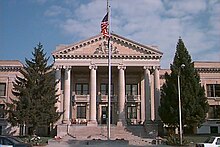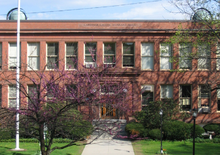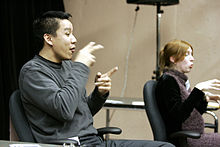User:Naiad013/sandbox
{{multiple issues|
The examples and perspective in this article may not represent a worldwide view of the subject. (January 2013) |

Deaf education is the education of students with various hearing levels in a way that addresses the students' individual differences and needs. Ideally, this process involves the individually planned and systematically monitored arrangement of teaching procedures, adapted equipment and materials, accessible settings, and other interventions designed to help learners of various hearing levels achieve a higher level of personal self-sufficiency and success in school and community settings than would be available if the students were only given access to a typical classroom education. Many countries focus on training teachers on how to teach deaf students. In addition, many approaches are taken to achieve the expected level of education and in order to build associations to protect deaf students.
Identifying deaf students
[edit]This section needs expansion. You can help by adding to it. (January 2013) |
Some children can be easily identified as candidates of deaf education from their audiogram or medical history.
Individual needs
[edit]Deaf education programs should be customized to address each student's unique needs. Deaf educators provide a continuum of service in which deaf students can receive in varying degrees based on their individual needs. It is essential for deaf education programs to be individualized to address the unique combination of needs for each student.[1]
In the United States, Canada, and the UK, educational professionals used the initialism IEP when referring to a student’s individualized education plan.
Methods of provision
[edit]Schools use different approaches to provide deaf educational services to identified students. These can be broadly grouped into four categories, according to whether the deaf student has contact with non-deaf students and how much (using North American terminology):
- Inclusion: In this approach, students with deaf educational needs spend all, or at least more than half, of the school day with students who do not have deaf educational needs because inclusion requires substantial modification of the general curriculum. Most schools only use inclusion for selected students with mild to moderate deaf needs, for which is accepted as a best practice.[2][3] Specialized services may be provided inside or outside the regular classroom, depending on the type of services. Students may occasionally leave the regular classroom to attend smaller, more intensive instructional sessions in a resource room, or to receive other related services that might require specialized equipment or might be disruptive to the rest of the class, such as speech and language therapy.[4]
- Mainstreaming refers to the practice of educating deaf students in classes with non-deaf students during specific time periods, based on their skills. Deaf students are segregated in separate classes exclusively for the rest of the school day.[5]
- Segregation in a self-contained classroom or special school: In this model, students with special needs spend no time in ordinary classes or with non-disabled students. Segregated students may attend the same school where regular classes are provided, but spend their time exclusively in a separate classroom for students with special needs. If their special class is located in an ordinary school, they may be provided opportunities for social integration, e.g., eating meals with non-disabled students.[6] Alternatively, these students may attend a special school.[5]
- Exclusion: A student who cannot receive instructions in any school is excluded from school. Historically, most deaf students have been excluded from school,[7] and such exclusion may still occur in some places where there is no legal mandate for special education services, such as in developing countries. It may also occur when a student is in hospital,[5] housebound,[5] or detained by the criminal justice system.[citation needed] These students may receive one-on-one instruction or group instruction. Students who have been suspended or expelled are not considered excluded in this sense.
Instructional strategies
[edit]There are some specialized instruction strategies used to teach deaf children.
Bilingual-bicultural education
[edit]
In this educational method, deafness is not seen as a medical issue; it is instead seen as a cultural issue.[8] In the bilingual-bicultural program, it is advocated that children who are deaf are taught ASL as a first language, then taught written and/or spoken English as a second language.[8][9] Bilingual-bicultural programs emphasize that English and ASL are equal languages, and they work to help children develop age-appropriate levels of fluency in both languages.[9] The bilingual-bicultural approach holds the belief that deaf children are visual learners as opposed to auditory learners.[8] Therefore, classes should be conducted in a complete visual language. Since American Sign Language and spoken English cannot be used simultaneously for fear of harming the accuracy and fluency of both languages, American Sign Language alone with no oral language, or voice-off ASL, is usually used. Many bilingual-bicultural schools have dormitories, and students can either commute to school every day or stay in a dormitory as part of the residential program and visit their families on weekends and/or holidays and school vacations.
Auditory-oral and auditory-verbal education
[edit]
The auditory-oral and auditory-verbal methods, sometimes referred to collectively as listening and spoken language, are forms of oral education.[10] These methods are based on the belief that a deaf child can learn to listen and speak so that his/her families do not need to learn sign language or cued speech.[11][12] These methods are presented as communication options, and they rely on a large amount of parental involvement.[11][12] Children who use this option may be placed in a continuum of educational placements including oral schools, such as Clarke Schools for Hearing and Speech, self-contained classrooms for deaf students in public schools, or mainstream classrooms with hearing students.[11][12][13]
Mainstreaming and inclusion
[edit]
Under this educational method, a deaf child attends public school in regular classes for at least part of the school day.[14] Students may receive accommodations such as itinerant teachers, interpreters, assistive technology, notetakers, and aides.[15][16] The benefits of inclusion include daily interaction with hearing students and the opportunity to live at home, but the drawbacks include isolation and limited availability of support.[15]
History of deaf education
[edit]John Bulwer, an English physician, [17] wrote five works exploring the Body and human communication, particularly by gestures. He was the first person in England to propose educating deaf people, [18] the plans for an Academy he outlines in Philocophus and The Dumbe mans academie.
France
[edit]Charles-Michel de l'Épée pioneered deaf education in France. He was involved in charitable work for the poor, and, on one foray into the slums of Paris, he had a chance to encounter with two young deaf sisters who communicated using a sign language. Épée decided to dedicate himself to the education and salvation of the deaf. In 1760, he founded a school. In line with emerging philosophical thought of that time, Épée came to believe that deaf people were capable of language and concluded that they should be able to receive the sacraments and thus avoid going to hell. He began to develop a system of instruction of the French language and religion. In the early 1760s, his shelter became the world's first free school for the deaf, open to the public.[citation needed]
Great Britain
[edit]At the same time the first school set up for the purpose of teaching the deaf to speak and read in Britain was Thomas Braidwood's Academy for the Deaf and Dumb in Edinburgh established in 1760s. The school moved to London in 1783 and was called the "Asylum for the Support and Education of the Deaf and Dumb Children of the Poor". Braidwood used an early form of sign language, the combined system, which was the forerunner of British Sign Language, recognized as a language in its own right in 2003. Braidwood's combined system that he pioneered is known among British Deaf historians as the Braidwoodian Method.[citation needed]
Under the management of Braidwood's nephew, the school ran successfully and soon expanded its premises. The example of this school stimulated the establishment of many others: an Institution for the Instruction of the Deaf and Dumb opened in Edgbaston in 1814 followed by others across the country - Liverpool, Edinburgh, Exeter, Manchester and Doncaster.[citation needed]
United States
[edit]Deaf education in the United States began in the early 1800s, when the Cobbs School, an oral school, was established by William Bolling and John Braidwood, and the Connecticut Asylum for the Deaf and Dumb, a manual school, was established by Thomas Hopkins Gallaudet and Laurent Clerc. When the Cobbs School closed in 1816, the manual method, which used American Sign Language, became commonplace in deaf schools for most of the remainder of the century. In the late 1800s, schools began to use the oral method, which only allowed the use of speech, as opposed to the manual method previously in place. Students caught using sign language in oral programs were often punished. The oral method was used for many years until sign language instruction gradually began to come back into deaf education.
Issues
[edit]This section needs expansion. You can help by adding to it. (January 2013) |
People often advocate for one of two broad categories in deaf education: manualism or oralism. Manualism is the education of deaf students using sign language and oralism is the education of deaf students using oral language. Since the beginning of the 18th century, these two philosophies have been on opposing sides of a heated debate that continues to this day, although many modern deaf educational facilities attempt to integrate both approaches. The National Association of the Deaf advocates for a bilingual approach to best support deaf students in their education.[19]
National approaches
[edit]This section needs expansion with: more worldwide coverage. You can help by adding to it. (January 2013) |
North America
[edit]In North America, deaf education is commonly denoted as DeafEd in a professional context.[citation needed]
United States
[edit]All deaf students receive an Individualized Education Program (IEP) that outlines how the school will meet the student's individual needs. The Individuals with Disabilities Education Act (IDEA) requires that students with special needs are provided with a Free Appropriate Public Education in the Least Restrictive Environment that is appropriate to the student's needs. Government-run schools provide deaf education in varying degrees from the least restrictive settings, such as full inclusion, to the most restrictive settings, such as segregation in a deaf school.[5] The education offered by the school must be appropriate to the student's individual needs. Schools are not required to maximize the student's potential or to provide the best possible services. Like most of the developed countries, American schools are also required to provide many medical services, such as speech therapy, if the student needs these services.
Canada
[edit]This section needs expansion. You can help by adding to it. (January 2013) |
Europe
[edit]This section needs expansion. You can help by adding to it. (January 2013) |
Asia
[edit]Nepal
[edit]Under law currently being enacted, deaf children in Nepal have the right to have free, qualified education in line with the provisions of the UN Convention on the Rights of Persons with Disabilities (UNCRPD). As yet, however, education in a school for the deaf is limited to some 13 dedicated schools for the deaf plus a slightly greater number of deaf resource classes located in regular schools. Theoretically, all these schools and classes are bilingual, with Nepali Sign Language and written Nepali being the medium of instruction. In practice, limited number of Deaf teachers and the minimal training hearing teachers are given in Nepali Sign Language, much of the instruction in these schools is via a pidginized form of Nepali Sign Language commonly referred to as Sign-Supported Nepali, and the teaching methodology tends towards some version of the Simultaneous Communication variety of Total Communication.
Teacher training
[edit]Deaf education majors and degree programs offer training and certification in the education of students with various hearing capabilities in a way that addresses the students' individual differences and needs. Deaf education also includes the study of special education, Deaf studies, education. sign language and Deaf culture (not all programs include the study of the latter two).
University-based deaf education centers
[edit]United States
[edit]- Doctorate offered:
- Gallaudet University,[20] Washington, D.C.
- Masters offered:
- National Center on Deafness, California State University, Northridge,[21] Northridge, California
United Kingdom
[edit]- University of Central Lancashire,[22] Lancashire, England
- University of Bristol,[23] Bristol
- University of Edinburgh[24] Edinburgh
New Zealand
[edit]- University of Wellington, Victoria , Victoria
The Netherlands
[edit]- Visual Language, Signs and Gestures, Max Planck Institute for Psycholinguistics, Nijmegen
Deaf education associations
[edit]- United States
- United Kingdom
See also
[edit]- Deaf studies
- Special education
- Deaf culture
- History of sign language
- Category:Schools for the deaf
- Category:Deaf universities and colleges
- Second International Congress on Education of the Deaf
References
[edit]- ^ Goodman, Libby (1990). Time and learning in the special education classroom. Albany, N.Y.: State University of New York Press. p. 122. ISBN 0-7914-0371-8. OCLC 20635959.
- ^ Smith, P (October 2007). "Have we made any progress, including students with intellectual disabilities in regular education classrooms?". Intellect Dev Disabil. 45 (5): 297–309. doi:10.1352/0047-6765(2007)45[297:HWMAPI]2.0.CO;2. PMID 17887907.
- ^ James Q. Affleck; Sally Madge; Abby Adams; Sheila Lowenbraun (January 1988). "Integrated classroom versus resource model: academic viability and effectiveness". Exceptional Children: 2. Retrieved 2010-05-29.
- ^ Bowe, Frank (2004). Making Inclusion Work. Upper Saddle River, N.J: Prentice Hall. ISBN 0-13-017603-6. OCLC 54374653.[page needed]
- ^ a b c d e Karen Zittleman; Sadker, David Miller (2006). Teachers, Schools and Society: A Brief Introduction to Education with Bind-in Online Learning Center Card with free Student Reader CD-ROM. McGraw-Hill Humanities/Social Sciences/Languages. pp. 48, 49, 108, G–12. ISBN 0-07-323007-3.
- ^ Warnock Report (1978). "Report of the Committee of Enquiry into the Education of Handicapped Children and Young People", London.
- ^ Wolffe, Jerry. (20 December 2010) What the law requires for disabled students The Oakland Press.
- ^ a b c Baker, Sharon; Baker, Keith (August 1997). "Educating Children Who Are Deaf or Hard of Hearing: Bilingual-Bicultural Education. ERIC Digest #E553". Education Resources Information Center. ERIC Clearinghouse on Handicapped and Gifted Children. Retrieved 23 January 2011.
- ^ a b Marschark, Marc; Lang, Harry G; Albertini, John A. (2002). Educating Deaf Students. New York: Oxford University Press. p. 145.
- ^ Cole, Elizabeth B.; Flexer, Carol (2011). Children with Hearing Loss: Developing Listening and Talking (2nd ed.). San Diego, CA: Plural Publishing. p. 348. ISBN 978-1-59756-379-6.
The two main Listening and Spoken Language approaches, historically, have been the Auditory-Verbal Approach (AV) and the Auditory-Oral Approach (A-O).
- ^ a b c Stone, Patrick (August 1997). "Educating Children Who Are Deaf or Hard of Hearing: Auditory-Oral. ERIC Digest #E551". Education Resources Information Center. ERIC Clearinghouse on Disabilities and Gifted Education. Retrieved 4 February 2012.
- ^ a b c Goldberg, Donald (August 1997). "Educating Children Who Are Deaf or Hard of Hearing: Auditory-Verbal. ERIC Digest #E552". Education Resources Information Center. ERIC Clearinghouse on Disabilities and Gifted Education. Retrieved 4 February 2012.
- ^ There's a new kid in school (mov). Oral Deaf Education. Retrieved 4 February 2012.
- ^ Marschark, Marc; Lang, Harry G; Albertini, John A. (2002). Educating Deaf Students. New York: Oxford University Press. p. 143.
- ^ a b Nowell, Richard; Innes, Joseph (August 1997). "Educating Children Who Are Deaf or Hard of Hearing: Inclusion. ERIC Digest #E557". Education Resources Information Center. ERIC Clearinghouse on Disabilities and Gifted Education. Retrieved 25 January 2011.
- ^ "School Placement Considerations for Students Who are Deaf and Hard of Hearing". Hands and Voices. 2005. Retrieved 23 January 2011.
- ^ Wollock, J (1996). John Bulwer and his Italian sources. In Mirko Tavoni (Ed.), Italia ed Europa nella linguisticadel Rinascimento, Atti del convegno internazionale, 20–24 March 1991, Ferrara, p.419
- ^ Dekesel, K. (1992) John Bulwer: The founding father of BSL research, Signpost, Winter 1992 & Spring 1993 P11-14 & p36- 46
- ^ National Association of the Deaf, Dual Language Development and Use in the Educational Environment Position Statement
- ^ [1]
- ^ "California State University website". Csun.edu. Retrieved May 2013.
{{cite web}}: Check date values in:|accessdate=(help) - ^ "UCLAN - Deaf Studies". Uclan.ac2.com. Retrieved May 2013.
{{cite web}}: Check date values in:|accessdate=(help) - ^ "Bristol University | Centre for Deaf Studies | Welcome to the Centre for Deaf Studies". Bris.ac.uk. Retrieved May 2013.
{{cite web}}: Check date values in:|accessdate=(help) - ^ [2][dead link]
Further reading
[edit]- A.A.P.T.S.D. The Association Review: 1906, Philadelphia, Penn.: American Association to Promote the Teaching of Speech to the Deaf. Retrieved from the Internet Archive, June 7, 2012. Note: this annual review contains extensive material on deaf education worldwide. It has been inadvertently listed on the Internet Archive as The Association Review: 1899, although some metadata correctly identifies it as from the year 1906.
- R.A.R. Edwards, Words Made Flesh: Nineteenth-Century Deaf Education and the Growth of Deaf Culture. New York: New York University Press, 2012.
External links
[edit]- List of deaf education teacher preparation programs in the United States and Canada
- Thomas E. Finegan (1920). . Encyclopedia Americana. This article has a section on deaf children.
Category:Area studies
Category:Deaf education
Category:Deafness
Category:Education
Category:Education for the deaf
Category:Philosophy of education
Category:Special education
Category:Teaching

